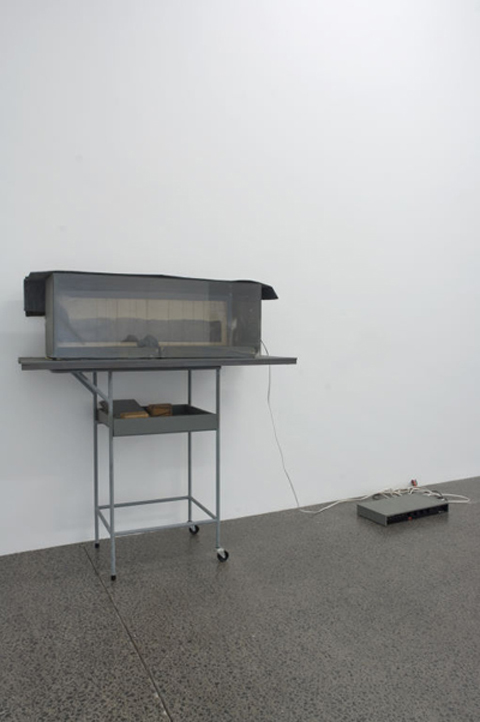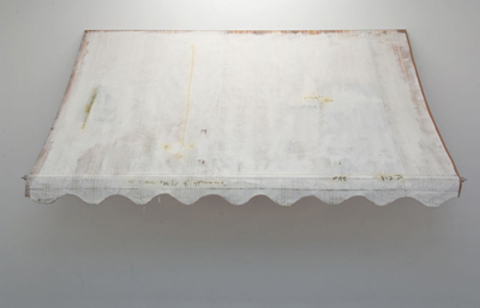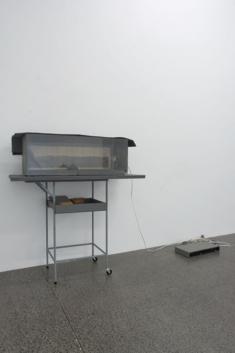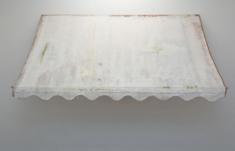Rob Garrett
Curator
The Death of L.Budd
by Amanda Wayers
Amanda Wayers reviews a 2008 retrospective of the late artist’s work.
The Estate of L. Budd commemorates and defines L. Budd’s life’s work in a retrospective exhibition at Michael Lett gallery, accompanied by a comprehensive catalogue raisonné. The project promises to make a definitive statement as to the identity of this elusive artist, creating a firm basis for interpretation and relieving the frustration of those who have struggled with et al.’s refusal to come forward and talk publicly about their art. However, as might be expected in this case, a promise is not a done deal.
The exhibition isn’t quite what you’d expect from a retrospective. It features only four works; one “disputed”, the others “approved”. None have been shown before in the form they now have. Two “blonded” awnings hang unfurled; the original colours of the canvas peeking through behind and around delicate veils of white paint, introducing an almost cheerful, subtly pretty element. They look like they could be “genuine” 90s L. Budd, though the dating of one (untitled, c.1997) hints that the work’s providence may be under question. Untitled (1992), a stack of silicon moulds supporting rolls of vintage wallpaper, “reproduces” a 1992 work with some license; originally, the wallpaper was hung on the wall, not rolled, and the supports were all plaster, not silicon.
All this suggests that the exhibition is not so much passively re-presenting the past, like a “proper” retrospective would, as actively interfering with it. It seems, like much et al. work, wilfully discordant. This time the discordance is between the project’s content and conventional exhibitionary form that it adopts: the “retrospective” accompanied by the “catalogue raisonné”.
The sanctioned project of the conventional retrospective and catalogue raisonné is to enable us to perform one of the key tasks of “approved” art interpretation processes: attribution; finding the source; identifying the origin/the subject/the referent. The aim is to form a complete, unbreakable duality from artist and artwork, in which each elucidates the other perfectly, producing a digestible, accessible, authenticated whole. The conventional retrospective and catalogue raisonné offer the author as the ultimate answer to all the work’s questions; once the origin has been identified, the work’s potential is exhausted. At the end of the process, the work is no longer live but dead: catalogued, historicised, authenticised, and packed away in a museum box.
The Estate of L. Budd, which was publicised as “an important exhibition of work” by the deceased artist, plays with this model and its murderous authenticating processes. Artworks are either “approved” or “denied” by the estate. One work in the exhibition, National Park (sorry) (2008), is listed as “disputed” on the exhibition list. At the opening, this work was out in the centre of the room. Later, it was wheeled to the side and covered with bubble wrap; power and opinion had obviously shifted amongst the trustees of the estate: the work is now closer to “denied” than “accepted”, and threatened with oblivion.
Where the stars of a conventional retrospective will usually be works from significant collections, the Estate catalogue and exhibition incorporate only the contents of the collective’s studio. Works in private and public collections are currently excluded from the artist’s oeuvre. Eventually these pieces may be submitted for approval by the trustees of the estate, but for now, all of them are “fakes”. What’s more, if they are eventually submitted, they may be denied. (This provocative action not only turns the usual art-valuing systems upside down, it also clears up any confusion about who made what et al. artwork, putting the control squarely back into the hands of the artists.)
Authenticity
The 264 page catalogue raisonné looks authentic and authoritative enough. It has all the trappings of a scholarly publication– forewords from curators, gallerists and writers (some seem pretty impressive), catalogue annotations, and appendixes, including one that ostensibly incorporates every piece of criticism ever written about L. Budd.
Its comprehensiveness, born of its claim to include every authenticated work, renders L. Budd’s practice ultimately accessible. It allows you to see everything at once, equipping you with basically everything you need to start constructing interpretations: every artwork in the oeuvre, all previous interpretations, all artist’s statements and interviews.
On closer inspection, though, this apparent clarity and unity falls apart. It appears that some of the works in the catalogue aren’t even by Budd. Some are signed by p. mule, another member of the collective. Others display the characteristics of work by other et al. members; characteristics that have been used previously by critics to define and separate their practice. The project deconstructs the artist’s identity and oeuvre as it constructs them; in fact, we don’t even know for sure if the deceased is l. budd, lionel b, lillian budd, or none of the above. Looking for L. Budd here is a fruitless search – an unfulfillable goal.
This discordance within L. Budd’s identity makes it difficult for the reader/viewer to extract an author from the artist’s oeuvre. A more complicated and ultimately realistic picture of the relationship between an artist and his/her production displaces this misleading and oversimplifying art historical trick. The kind of access that The Estate provides to L. Budd is actually quite genuine. It reflects the difference between the artists’ lives and their art, and makes room for diversity in their work.
Normally, an artist’s death will make him or her more susceptible to the identity-producing machinations of the retrospective and the catalogue raisonné. But in this case, like in Barthes’ Death of the Author, the death of the artist is not negotiable: L. Budd will not be resurrected (not in that way, anyway).
Reality check
In case you are getting gleeful at the prospect of getting hold of what would amount to a sales catalogue of freshly authenticated and available artworks by a lucratively deceased artist, I’m sorry to disappoint you (at least for now). Sales of works in the show and catalogue will be tightly restricted. This is not surprising; the gallery and the artists need to avoid benefiting overtly from the validating and authenticating process they have effectively put into place. This would make them too real; the authentication processes that the project mimics and mocks can’t help being effective.
This project illustrates the power of the retrospective and catalogue raisonné format, exposing how we respond to these forms in the way we are conditioned to, regardless of discord within the project that should make this impossible.
The Trustees
The myth of the solo artistic genius is dead in the water here. It is not possible to identify a single artist, biologically defined, that is individually responsible for the creative content of this project. Even the boundaries of the collective are broken: the trustees of the estate are not just et al.; others are involved too, including gallerist Michael Lett. Lett and his staff were instrumental in “making this project happen”, extending the usual role of gallerist and contributing conceptual and aesthetic aspects to the project as well as organisational ones. The title and structure of this project acknowledge the true collective nature of exhibition development processes.
The Estate of L. Budd draws a fine, meandering and sometimes disappearing line between truth and fiction, to the point where it is hard to tell which is which. The structure is real, the methods are real, and the authentication is real. But the results delivered by these authenticated and widely accepted art interpretation processes are dubious. The “reality” they produce is constructed, not unveiled, and you are alerted to the fact that they could be constructed differently to suit different purposes. By employing sanctioned investigation systems in a project where the truth can never be realised, The Estate of L. Budd exposes the real as contingent upon unreliable factors; as socially constructed and susceptible to human desire.
Just how authentic could the death of the artist really be, though, considering the fact that this whole project seems geared to question authenticity and its processes? “The estate makes no claims” as to the future status of this expiration, or discontinuation, if you like.
The project really starts to work when its inconsistencies cause it to fall apart: the instability of the structures it parodies is revealed in the cracks between its ostensibly earnest attempts at “making sense”. What amounts is a finely orchestrated, revealing disharmony of human attempts and failures (a description that, ironically, could apply, and has been applied, to the whole of et al.’s rather consistent oeuvre).
Previously published in Art World, Issue 3, June-July 2008, pp59-61.
L. Budd (active c. 1990 – 2000), formerly a member of the et al. artist’s collective, has passed away.



